
Birds are renowned for being early risers. Just ask Celeshia Guy. She knows this from personal experience.
Celeshia is the assistant manager at Belize Bird Rescue, a not-for-profit organization operating on a private reserve nestled at the very heart of Belize in Central America. The rescue centre, the only one of its kind in Belize, takes in native birds that have been rescued from Belizean homes or confiscated from poachers. They also receive parrots from locals who seek medical help.
From nest egg to aviary
It was founded in 2004 by Nikki Buxton and Jerry Larder, UK expatriates who moved to Belize to retire, but life had different plans for them.
When they arrived in early 2004, they received 3 unwanted parrots from locals. Gradually, more people came and dropped off their birds. The couple’s home quickly went from a nice retirement nest to a busy aviary.
Later that year, they founded Belize Bird Rescue and dedicated its resources to rehabilitating rescued native birds. It currently houses 80 parrots, 2 toucans, 2 raptors, a frigate bird and a wood-rail in 26 outdoor enclosures, including three 80-foot flight aviaries.
Privately funded since 2004, the rescue centre applied for NGO status in 2013.
Early wake-up call
One of Celeshia’s many job functions is to prepare and serve breakfast for the centre’s feathery denizens. She shares this responsibility with co-founder Nikki, who performs the same task on alternate days.
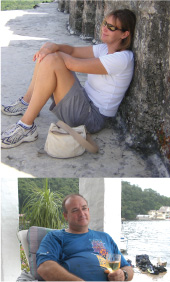
Belize Bird Rescue co-founders Nikki Buxton and Jerry Larder moved to Belize to retire, but life had different plans for them.
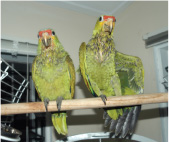
This pair of unwanted birds were among the first to be dropped off at Belize Bird Rescue.
Breakfast is at 7:30 am. This means that Celeshia or Nikki literally have to get up before the birds to prepare the morning meal. Celeshia’s wake-up call is 6:30 am. She has 1 hour to prepare 40 plates.

Breakfast at Belize Bird Rescue consists of fresh fruits and vegetables.
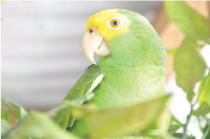
A Yellow-headed Amazon living in the wild can live up to 80 years. Captive ones generally live 1 to 5 years due to malnutrition, neglect, and indifference.
Fortunately, she lives only minutes away from the centre. She gets there in plenty of time to chop fresh vegetables and fruits, which are always on the morning menu.
Victims of cultural mindset, poaching and deforestation
Keeping a parrot at home is a deeply-rooted custom in Belize that dates back many generations. It’s not uncommon for locals to capture and keep wild birds.
This long-time practice has severely depleted the wild parrot population, specifically the once flourishing Yellow-headed Amazon.
The species has also been ravaged by poaching. A Yellow-headed Amazon, for instance, can sell for $400 US, which is more than the average monthly household wage in Belize. Deforestation and forest fires have also taken a toll on the parrots.
Celeshia was in Montreal recently on a 10-day learning mission at HARI (Hagen Avicultural Research Institute). During her stay, she gave an excellent presentation at Hagen Head Office about Belize Bird Rescue and the current state of native parrots in her country. Her presentation was attended by many bird enthusiasts, including staff at Le Nichoir, a non-profit organization dedicated to rehabilitatng injured or orphaned wild birds.
Celeshia, who has a Bachelor of Science Degree in Natural Resource Management, spoke about the terrible plight of Yellow-headed Amazons and estimated that there were less than 1000 wild ones left in Belize. The species is considered endangered by the International Union for Conservation of Nature (IUCN).
She explained that while it is illegal to keep wild parrots in Belize, lack of resources makes the law difficult to enforce. The Forest Department is in charge of confiscating illegally kept parrots and bringing them to the centre.
Disposable pets
She said that most native parrots, such as the Yellow-headed Amazon, arrive at the centre in bad shape–they’re injured, malnourished, severely wing-clipped, and self-abusive due to years of living in enclosed cages, improper diets, and isolation.
“Life expectancy for a Yellow-headed Amazon living in the wild is usually 60 to 80 years. Captive ones generally live 1 to 5 years due to malnutrition, neglect, and indifference. They’re treated like disposal pets and not like companions,” said Celeshia.
Three R’s
Belize Bird Rescue’s mission is to rescue, rehabilitate and release the wild birds they harbour. The whole process usually takes at least 24 months of hard work and dedication by the whole team at the centre.
“In 2012, the centre released several Red-Lored Amazons who are still alive and well today. One pair even had babies. Parrots deemed to be too habituated and lacking the necessary skills to survive in nature are kept back at the sanctuary,” said Celeshia.
Yellow-headed Project
In 2011, the Belizean government authorized Belize Bird Rescue to begin a captive breeding program to help save the endangered Yellow-headed Amazon.
Celeshia said the centre currently has 11 Yellow-headed Amazons. Their goal is to pair up and breed Yellow-heads and release their offspring into the wild.
To date, no successful breeding has occurred, but she hopes that things will change with the knowledge she gains at HARI.
HARI helps Belizean Rescue Projects
Celeshia heard about HARI through Marc-André Villeneuve who is the Bioecology Technician at HARI.
Marc-André was in Belize in July 2013 to observe and assist the Scarlet Macaw Conservation Project, which is led by Charles Britt and Roni Martinez.
The project is dedicated to saving the endangered Scarlet Macaw. It receives financial support from HARI, Loro Parque Fundación and Rainforest Restoration Foundation.
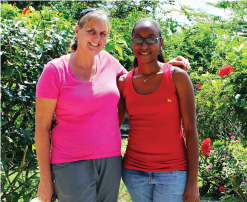
Belize Bird Rescue co-founder Nikki Buxton (left) with Celeshia Guy.
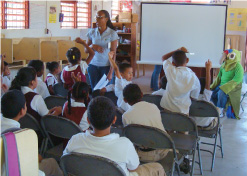
Celeshia Guy teaching local kids about parrot conservation.
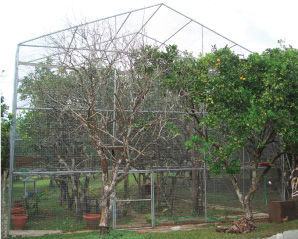
Feeding stations in the pre-release flights are located very high so that birds learn to find food up high in the trees.
Team members of the project monitor and protect wild chicks by camping under nesting trees–24 hours a day, seven days a week–until the birds reach fledgling age and quit the nest, explained Marc-André.
“The team now wants to try a different approach. They plan to take the chicks out of the nests and raise them in a secure facility to ensure the safety of the birds and the caretakers. This method will also allow the parents to double-clutch, thereby increasing the number of chicks per season. It has already been successfully done in many other parrot conservation projects in other countries, including neighbouring Guatemala. Even with this technique, they will not stop monitoring the nests in the wild,” Marc-André noted.
Perfect Collaboration
“However, building and maintaining a new facility is expensive. The project needed a more affordable alternative. Since Belize Bird Rescue already had a functional facility with electricity, water, flights, lots of field space, a nearby support network, and knowledgeable caretakers, it was seen as the perfect place to keep the chicks,” he said.
“When the idea was proposed to Nikki at Belize Bird Rescue, she was very interested, however, the centre would need training on chick care and feeding.”
“This is the reason for Celeshia’s visit to HARI. She received hands-on training on a wide range of bird care skills, including captive breeding techniques, sexing, restraint methods, medical work, checkups, and making natural remedies for treating ailments.”
Marc-André sees the end result as the perfect collaboration between the Macaw Conservation Project, Belize Bird Rescue, and HARI.
To further help rescue efforts in Belize, Mark Hagen, Director of Research at Rolf C. Hagen Inc. and HARI, donated $500 on behalf of HARI to Belize Bird Rescue, through the World Parrot Trust.
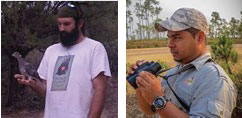
The Scarlet Macaw Conservation Project is led by Charles Britt (left) and Roni Martinez.
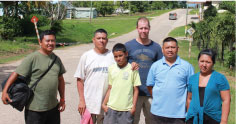
From left to right: Rudi May, Belarmino Quiroz with his son Mayron, Marc-André Villeneuve, Luis May and Sarah. Rudi, Belarmino and Luis are part of the Project's Scarlet Six Team.
“Thanks to the esteemed teams at HARI and Hagen Industries for giving me the chance to visit their facilities and learn so much. It was definitely a stepping stone in my career. I will go back home with a wealth of knowledge that will be used in my work at Belize Bird Rescue. Everyone truly showed me much love in Montreal and I am so grateful for the exceptional times during my 10-day visit,” concluded Celeshia.